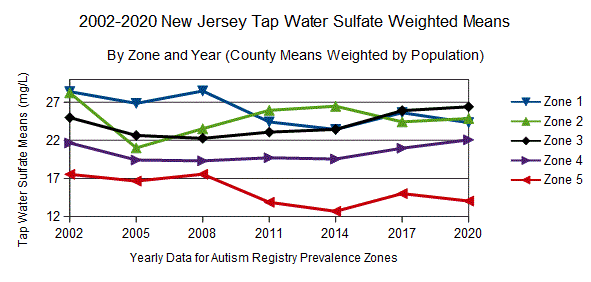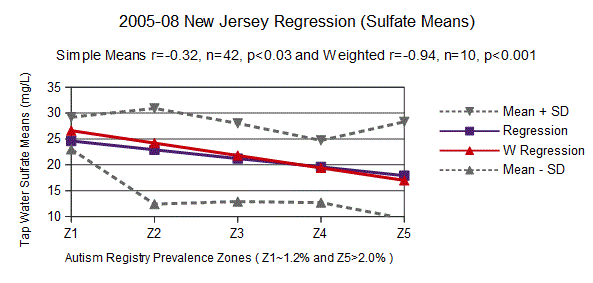Autism
Projects: New Jersey Prevalence Study
As noted previously, the basic premise of
the Brimstone Theory
is simple: disturbed metabolism of the oxides of sulfur cause autism.
In particular, sulfite is not properly processed resulting in low
levels of beneficial sulfate in blood. Avoiding sulfite in food and
sulfur dioxide in drugs can help. Also, a diet rich in sulfate may be
preventative. Unfortunately, sulfate in our water supply has been
reduced by widespread consumption of purified bottled water and the
well intentioned cleanup of the environment. The
problem is easy to correct by adding sulfate to water or switching to
sulfate rich bottled water. But first, we need to prove the theory is
correct. That was the goal of our second research study which is
summarized
below from a paper published in November of 2021 by the Biomedical
Journal
of Scientific and Technical Research.
Autism
Prevalence in New Jersey Correlates with Low Sulfate
in Tap Water
Abstract: We
examine autism prevalence in New Jersey (USA) and its relationship to
sulfate in local tap water. Our previous work indicates that sulfate
deficiency during early development increases the risk of autism. In
this current study, prevalence is obtained from the report “New
Jersey Autism Registry” on the state Department of Health website.
The report analyzes prevalence for eight-year-old children born in
2006. The sulfate concentration of public water is calculated from
test data reported in the Drinking Water Watch database. Counties are
grouped into five prevalence ranges and tap water analyzed for the
years 2005-2008, a period covering pregnancy through infancy. For
this data set, the population weighted sulfate means correlate
strongly with prevalence (correlation r=-0.94, n=10, p<0.001).
This correlation, the literature and previous work suggest that
increasing sulfate may help reduce the incidence of autism.
Introduction: Autism
Spectrum Disorders (ASD) affect social interaction, communication,
behavior and the senses. As of 2016, the prevalence was 1 in 54 for
the full United States based on data from the Centers for Disease
Control and Prevention (CDC). Prevalence in the state of New Jersey
was even stronger at 1 in 32, giving New Jersey the highest rate of
autism in the country. It is not well understood why
this should be true. Reported reasons mention New Jersey's reputation
for good diagnostic services along with a population characterized by
high risk factors, including advanced maternal age, elevated
premature rates and low birth weights.
It
is the purpose of our study to introduce another factor, sulfate
deficiency during pregnancy and infancy. Toward this end, we
calculate sulfate concentrations in local tap water using the New
Jersey Drinking Water Watch database. We determine the sulfate
content of private well water using Geological Survey Reports and the
New Jersey Private Well Water Testing Program. Then, we compare this
data with autism prevalence rates for the birth year 2006 from the
New Jersey Autism Registry, seeking the strength of correlation. A
strong correlation would suggest that ingested sulfate may be a
significant factor in the distribution of autism throughout New
Jersey. If the correlation is also inverse and sulfate can be shown
to be essential for brain development, it would suggest that
increasing the sulfate from food and water may reduce the incidence
of autism in New Jersey and elsewhere.
New Jersey Autism Registry: In
2009, New Jersey created the Autism Registry to better serve the
needs of children with autism and their families. All children up to 21
years of age, diagnosed with autism and
living in New Jersey are required to be registered. Once registered,
families are linked to Case Management Services to provide guidance,
resources and support. As of the year 2020, over 32,000 children had
been included, making this registry the largest in the country.
The
Autism Registry provides data to the New Jersey Department of Health,
enabling a better understanding of ASD. In
particular, a graphic is available on their website which presents a
map of New Jersey with counties color coded to show relative
prevalence. A similar graphic is presented in Figure 1 derived from
the New Jersey data. The map strategy focuses on eight-year-old
children born in 2006 to best represent a meaningful comparison
between counties. New Jersey's 21 counties are grouped into 5
prevalence ranges which we designate as Zones 1 through 5. Zone 1
includes counties with the lowest prevalence while Zone 5 includes
counties with the highest rates of autism.

Figure 1. Distribution of Autism in New Jersey for Birth Year 2006.
Results in Graphical Form: The
results are best visualized with the help of line graphs. To
illustrate the data, sulfate means for prevalence zones
are plotted for each 3 year period from 2002 through 2020. Figure 2
shows population weighted
means, representing the tap water available to typical
residents of a zone. The graph demonstrates significant separation
between zones for most years.
Figure 2. Sulfate in Tap Water
Reported as Population Weighted Means For Each Zone
Focusing
on the years 2005
through 2008, to highlight maternal pregnancy and early infancy for
children born in 2006, a cleaner view of sulfate means may be
presented. Linear regressions for sulfate means and population weighted
means are shown in Figure 3, plotted against each of the 5 prevalence
zones. As expected, the curves depict a general decline
in available sulfate as prevalence increases.
Figure 3. New Jersey Sulfate
Regression for the Years 2005-2008.
Conclusion: Using
sulfate in tap water as an indicator for dietary sulfate, we compare
the county by county distribution of sulfate in water to the
prevalence of autism. We use published prevalence rates from the
Autism Registry for the birth year 2006. Then we calculate sulfate
concentrations for over 600 water systems as cataloged in the New
Jersey Water Watch database. Concentrating on the years 2005-2008 to
represent maternal pregnancy and child development through infancy,
we compare the sulfate means for water against autism prevalence in
all 21 New Jersey counties. The resulting correlation of a linear
regression analysis shows a significant, although mild, relationship
between sulfate and autism prevalence. When the simple sulfate means
are adjusted to population weighted means to better represent the
sulfate available to a typical family, the correlation becomes very
strong (correlation r=-0.94, n=10, p<0.001). This is a
surprisingly robust indicator even though other factors may likewise
contribute to the development of autism. Based on our results, it may
be possible to significantly reduce the incidence of autism by
supplementing with sulfate rich food and water during pregnancy and
early childhood. Examining New Jersey data, increasing sulfate
concentrations in tap water by as little as 10 mg/L may reduce autism
prevalence by meaningful margins.
The
medical literature shows sulfate to be a necessary nutrient,
important for organ development, brain function and toxin removal. In
those with autism, blood sulfate concentrations are well below
neurotypical levels. Our previous Facebook study correlated autism
severity with low sulfate in beverages consumed during pregnancy. Our
current study documents a strong correlation between autism
prevalence in New Jersey and low sulfate in local tap water. These
are very hopeful clues to autism prevention. To view the full article,
click on the link below.
|

|
Hosted by
Rybett Controls
|

|



